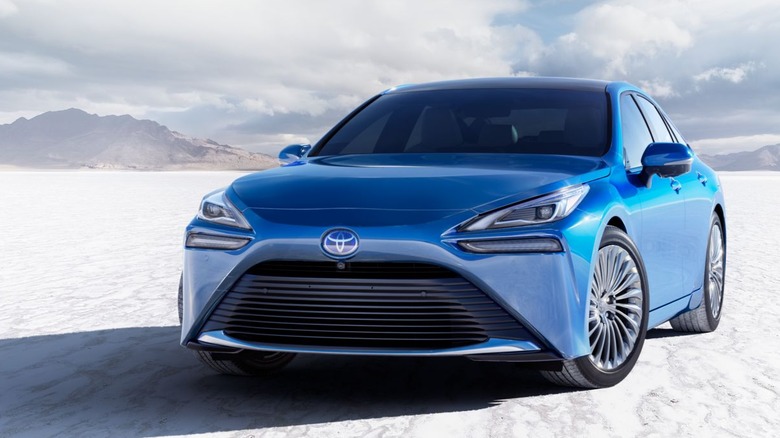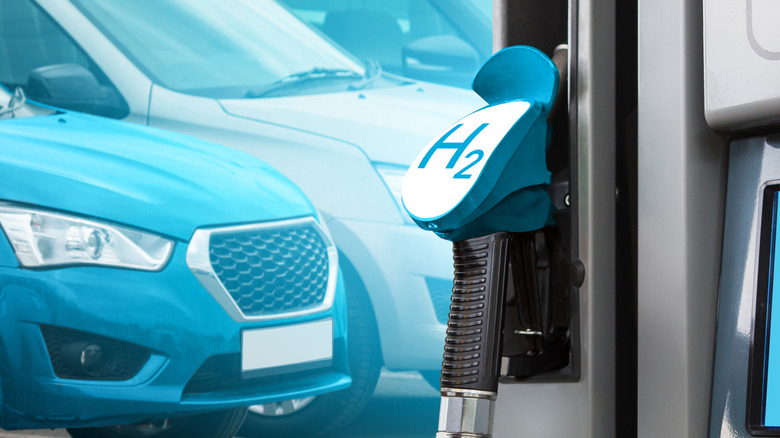Here's Why Hydrogen Cars Were Doomed To Fail
Zero-emission vehicles are on a roll as evidenced by the 6.4 million electric and hybrid cars that were sold in 2021 (via Green Cars). In fact, Cars.com reported a 173% jump in EV searches between February 24 and March 25, 2022, and Tesla orders for the second week of March, in the same year, reportedly increased by 100%, according to sources speaking with Electrek. This, naturally raises a big question: why were hydrogen cars left out of the green mobility revolution? The answer is fairly simple and can be boiled down to costs, technology, security, and infrastructure.
Around 2010, hydrogen cars were viewed as something that may change the world; they began to battle their fully electric counterparts to dominate the market, but lithium-powered cars rapidly outgunned them. Major car brands like VW, today a global EV producer, phased out all hydrogen models. Why? When hitting the streets, it's all about energy efficiency, and hydrogen cars have half the power of an all-electric alternative, BMW says.
When you step on the gas of an all-electric vehicle, the energy runs directly from the battery through the wires to the engine. For every 100 watts of power, only 5% is lost from battery to turbine, The Conversation explains. However, when it comes to hydrogen cars, the loss of power begins much earlier in the journey.
Hydrogen needs to be cooled down and transported to a hydrogen station, and this alone represents a 10% loss of power. Once inside the car, hydrogen must be converted into electricity, at which point another 40% of energy is lost. Finally, 5% more goes to waste when energy makes the motor hum. Just 38 out of 100 watts make it through the energy journey in a hydrogen car. In a world that continually pushes to advance technology for energy efficiency, these numbers make it clear that hydrogen is not an ideal solution.
Costs, dangers, and infrastructure
As the trend to switch to green vehicles gains momentum, something currently driven by high gas prices caused by the Russia-Ukraine war, drivers are looking for affordable alternatives to cut their fuel dependency. EV prices can go as high as $140,490 for a Tesla Model S Plaid, but, on average, affordable models range from $30,000 to $40,000. Hydrogen cars, in contrast, struggle to be price competitive. While some options are cheaper, including the Toyota Mirai hydrogen fuel cell car that sells for $50,000, these are just exceptions.
By 2021, it became evident which technology had won the battle for sustainable transportation. A study titled Global Market for Passenger Hydrogen Fuel Cell Vehicles reveals that only around 27,500 hydrogen vehicles were sold by the end of 2020 — and that's the overall figure since the sales of these vehicles started, not just the number of cars that were sold during that particular year. While the study seems optimistic that hydrogen cars will take off, consumer perception of hydrogen's safety doesn't play in its favor.
Forbes cites two incidents that tainted hydrogen cars' safety reputation. In 2019 in Santa Clara, California, a hydrogen plant exploded and then, only weeks later, a refueling station in Norway followed. People came to realize the fuel that NASA uses to fire up its rockets wasn't necessarily the safest option for going green.
The final nail in hydrogen's coffin was hammered down by the lack of infrastructure and charging stations. In 2019, there were only a couple of hundred hydrogen charging stations globally, most of them concentrated in Japan, Asia, and Europe (via Statista). The number of stations in the U.S. is particularly low, with the U.S. Department of Energy reporting that there were only 39 public hydrogen stations by January 2018, nearly all of which were in California.
Reuters dug through U.S. Department of Energy data and reported that as of 2021, there were around 43,000 publicly-available EV charging stations in the U.S., which worked out to approximately 120,000 charging ports. Compare that with the number of hydrogen stations, and the writing on the wall is as clear as it can be. Hydrogen cars were once positioned as the next big thing, but EV technology over-powered them and inevitably set them up for failure.

